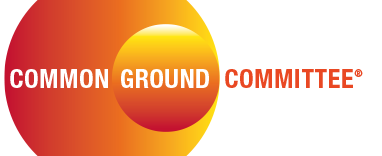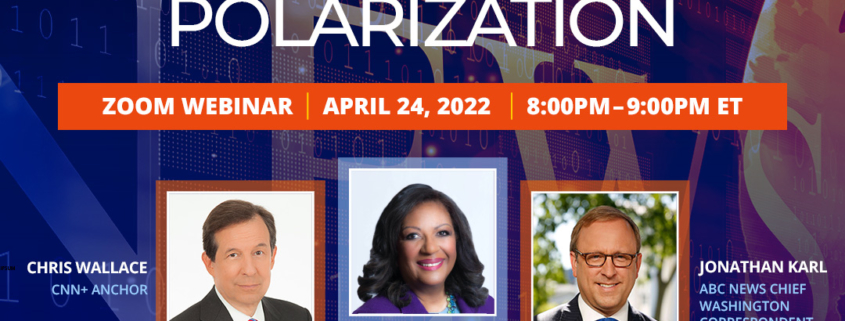Media, Politics and Polarization
What is the role of the media in our current state of polarization, and the twisting of facts to suit an agenda? That was the topic of a panel with Chris Wallace of CNN and Jonathan Karl, ABC’s Chief White House Correspondent. The event, “Media, Politics, and Polarization,” was hosted by former CBS correspondent and author Jacqueline Adams.
There were three main topics on the table: the perception of media as increasingly polarized; the power of the media; and the solutions for fixing distrust of the media.
Why do you think there’s such a public distrust of the media? Jacqueline Adams asked. She cited a Gallop poll last year that indicated increasingly skeptical public opinion of the media – particularly among Republicans.
Karl said he didn’t find that surprising, since the most prominent Republican, and president of the U.S., Donald Trump, called the media the public enemy of the people. But the progression was already underway, Wallace pointed out. The reason for Fox’s rise back in the late 90s was that a large part of the population felt underserved. Fox gave them a news outlet that they hadn’t seen before Trump was an accelerant. It was an answer to their sense for decades that the mainstream media wasn’t speaking to them.
How powerful is the press, really? Adams suggested the influence could be seen in its real-world impact—most recently, as a driver of perception about COVID. She presented the results of a study that demonstrated a dramatic difference of opinion toward the pandemic: Those who watch MSNBC reports on COVID risks expressed three times as much concern over the risk of COVID than viewers of Fox did.
Democrats and Republicans had a very different slant toward the lockdown, Wallace said, comparing it to the polio generation’s embrace of the vaccine, which was not at all political. Today, he said, the response to COVID and the vaccine was an echo chamber of politics and media. “Media kind of followed the political divide,” he said. “It didn’t create the political divide.”
What options does the media have to reduce the divisions among its programming, and viewers? Adams asked. Fact-checkers are already working overtime to reality-check the spin put on by both parties. What’s the solution to dial this back to center?
Karl interjected that he felt uncomfortable with the characterization of “the media this, the media that.” The media is such a diverse landscape, he said, with a wide range of outlets—from Twitter to podcasts and newspaper comments feedback online — that it can’t be painted with one brush. Most news consumers will follow the feed that matches their beliefs. Not surprisingly, many outlets don’t mind the divide, and in fact, benefit from fanning the flames.
“We’re not two political philosophies,” Wallace said, “We’re two tribes, with not just different beliefs, but different truths.” If you’re a politician moving toward the middle, there’s the fear of reprisal by your competition. Until there’s a market incentive to compromise, there’s a lack of motivation for finding common ground. “I have a good friend who deals with news start-ups, both print and digital, and he was making a pitch to investors to tell it down the middle,” Wallace said. The investors told him, that the market doesn’t reward that—it rewards news with a point of view. “Until we can get away from that, news as a business, you’ll take a loss if you tell it straight.”
What if the news networks stopped giving air time to guests who make outrageously biased statements? Adams asked. How much do ratings play into the choice of topics and guests?
If I don’t do well in ratings, Karl said, I’m probably not going to have the chance to continue what I do. But mistakes happen when you focus purely on ratings. Years ago, whenever there was a car chase, they’d cover it live in real-time. Then it becomes, “My God, where’s it going to go?” “When are they going to catch them?” It was beyond OJ and the Bronco. You gain an audience,” he said. “But it doesn’t work over time and erodes the brand” “CNN’s brand was, ‘News You Can Trust.’ Look at Chris Cuomo bringing his brother on. People watched again and again. But it eroded some credibility.” You can’t just look at ratings, he said, because it will be a failed business model in the end.
The takeaway, Wallace said, should be that there doesn’t need to be too much wringing of hands, because there’s some great reporting happening every day. “In the end, it’s really on citizens: do you want a different government and climate, political ecology? It’s on each of us in our various roles to push for it.”
There’s plenty of space for opinion journalism, Karl said, but we need to have news organizations dedicated to nothing more than pursuing the facts and truth as far as we’re able to discern it. “My opinion is that we’re in an extremely polarized period, but we’ve had this before, perhaps worse,” he said. “The pendulum will swing.”
To see the full event, you can watch the recording.





